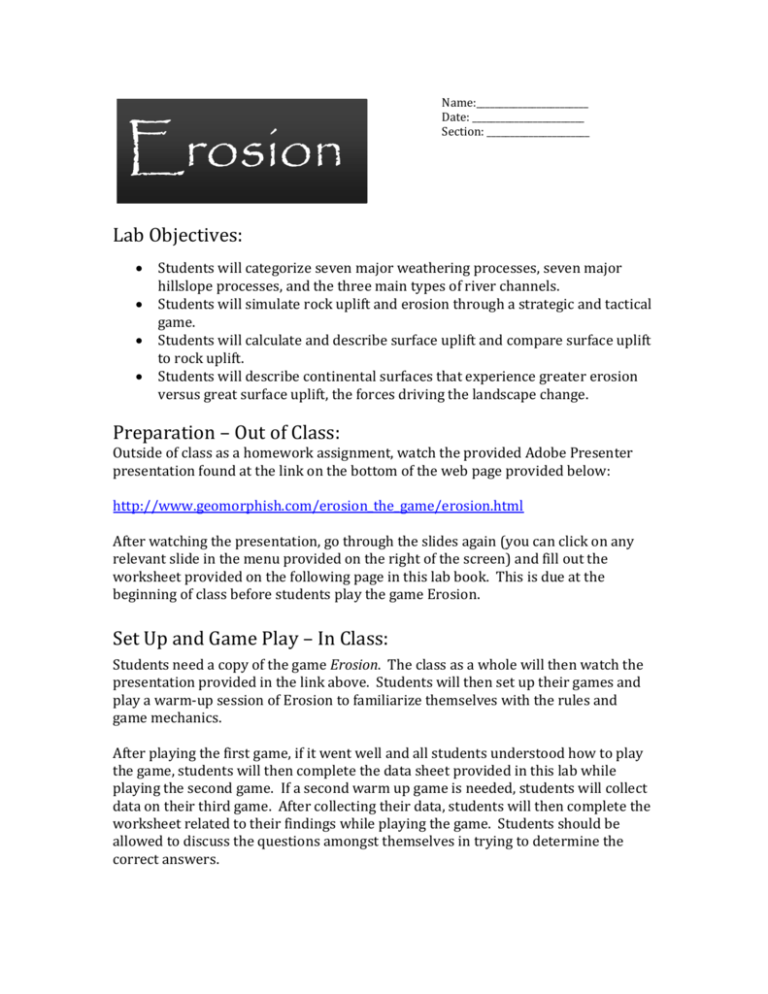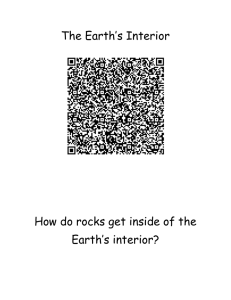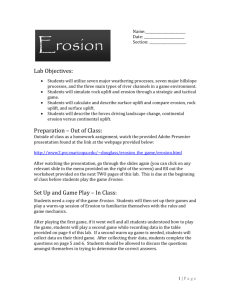Lab Objectives: Students will categorize seven major weathering
advertisement

Erosion Name:________________________ Date: ________________________ Section: ______________________ Lab Objectives: Students will categorize seven major weathering processes, seven major hillslope processes, and the three main types of river channels. Students will simulate rock uplift and erosion through a strategic and tactical game. Students will calculate and describe surface uplift and compare surface uplift to rock uplift. Students will describe continental surfaces that experience greater erosion versus great surface uplift, the forces driving the landscape change. Preparation – Out of Class: Outside of class as a homework assignment, watch the provided Adobe Presenter presentation found at the link on the bottom of the web page provided below: http://www.geomorphish.com/erosion_the_game/erosion.html After watching the presentation, go through the slides again (you can click on any relevant slide in the menu provided on the right of the screen) and fill out the worksheet provided on the following page in this lab book. This is due at the beginning of class before students play the game Erosion. Set Up and Game Play – In Class: Students need a copy of the game Erosion. The class as a whole will then watch the presentation provided in the link above. Students will then set up their games and play a warm-up session of Erosion to familiarize themselves with the rules and game mechanics. After playing the first game, if it went well and all students understood how to play the game, students will then complete the data sheet provided in this lab while playing the second game. If a second warm up game is needed, students will collect data on their third game. After collecting their data, students will then complete the worksheet related to their findings while playing the game. Students should be allowed to discuss the questions amongst themselves in trying to determine the correct answers. Erosion Presentation Homework Worksheet 1. The game Erosion simulates the struggle between orogeny (mountain building) and erosion. What processes drive orogeny? 2. What processes drive erosion? 3. In the game Erosion, what two features of the landscape are players in control of during game play in their own player area? 4. While playing the game, a player is in control of three distinct card locations in their own player area. List and describe the function of these three distinct card locations? 5. How many and what type of cards make up a player’s hand at the beginning of the game? 6. What are the names for the three different draw decks used in the game? 7. When rock is weathered on a player’s mountain, how is this shown in the game? 8. What is the definition of the weathering process sheeting? 9. Where is the “river” located during game play? 10. How are weathered cards transported to the river during game play? 11. What is the definition of the hillslope process debris flow? 12. Fluvial processes are the trickiest part of game play. When a player discards a fluvial card to transport a rock card from the river into their delta, what else must they discard and how must that card match the rock card being transported to the delta? 13. After which actions in the game can a player uplift their own mountain? 14. After a draw deck runs out, how many times must a player pass in a row to end the game? 15. How many points does a player earn if a rock card with a fossil on it is weathered on their mountain? 16. How many points does a player earn for each rock card in their delta? 17. How many points does a player earn for each un-weathered rock card in their mountain? 18. When setting up your mountain at the beginning of the game, how many cards do you need and which type of cards do you use? Erosion Data Sheet – Data collection during game play The first player needs to keep track of the round during the game. A new round starts at the beginning of their turn (their first turn starts round one, their second turn starts round two, etc.). To keep track of this, simply circle the game round number currently being played in the left column of the data chart. Each player records the data below per round (shaded). When playing with multiple players, use a series of checks that can be totaled following the conclusion of each round and before the beginning of the next round. After the game: 1. Total and calculate the data collected during game play 2. Collect the end of game data in the right column of the data chart 3. Calculate the rates of landscape change at the end of the chart Game Round: Example Rocks Uplifted 2 Rocks Weathered Rocks Hillsloped 3 1 Rocks Delta 2 1 2 3 4 5 6 7 8 9 10 11 12 13 14 End of Game Data # of fresh rocks on your mountain # of WX rocks on your mountain # of rocks in the river Total Average Calculations Rock uplift rocks uplifted average / 2 = km / Ma WX rocks weathered average / 2 = km / Ma Erosion rocks hillsloped average / 2 = km / Ma Surface Uplift Rock uplift rate – Erosion rate = km / Ma Depositional rate # rocks in all deltas / 2 = km / Ma # rocks uplifted on all mountains / 2 All mountains rock = km / Ma uplift rate All Mt. rock uplift rate - Dep. rate Orogeny versus = km / Ma Erosion # of rocks in all deltas # rocks uplifted on all mountains Erosion Data Questions: 1. Who won the game and what strategy did they use to win (discuss with all players)? 2. What is the difference between the erosion rate, rock uplift rate, and surface uplift rate? 3. How does your mountain’s surface uplift rate compare to other mountains and continental surfaces in the world (circle the location that more closely matches your mountain)? Wichita Mts. Midwest U.S. -0.15 km / Ma Flinders Range Australia 0.03 km / Ma Banda-Arc Mts. Indonesia 0.3 km / Ma Finisterre Mts. New Guinea 0.8 km / Ma Himalayan Mts. Asia 1.2 km / Ma 4. The “Orogeny versus Erosion” rate you calculated is either positive or negative. If orogeny is winning the rate is positive, and if erosion is winning the rate is negative. The values are simplified and do not reflect numerous other variables that go into such calculations (volume of rock, isostatic adjustments, continental flexing, etc.). Nevertheless, what is the implication for a continent where orogeny is winning? What is the implication for a continent where erosion is winning? 5. The number of rocks in the river at the end of the game suggests what kind of climate dominated your mountains and the amount of rock uplift that took place. If the rate of rock uplift is high, but the river is clogged with a lot of rock cards, what would this mean about the prevailing climate? 6. Continuing from the last question, if the rock uplift rate was high but the weathering and erosion rates were also high with only a few rocks in the river, what was the prevailing climate, why? 7. During game play someone’s mountain likely experienced high weathering rates but low erosion rates (little hillsloping), but eventually someone plays a landslide or debris flow card and all that weathered material enters the river in single large event. Would you like to live under a mountain that experiences these kinds of rare but large hillslope events or a mountain with roughly equal weathering and erosion rates, why? 8. If mountain building shutdown worldwide, what would eventually happen to the surface of the world’s continents? What if the hydrologic cycle shutdown? 9. Please think about a mountain range that you have seen in your lifetime. Picture that mountain range. How has playing this game changed your thinking about this mountain range? 10. Has playing this game changed how you think about the weathering, erosion, and deposition of sediment over Earth’s landforms? How?









